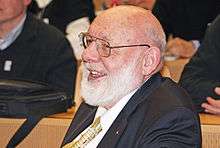Walter Jakob Gehring
| Walter Jakob Gehring | |
|---|---|
 Walter Jakob Gehring (2014) | |
| Born |
20 March 1939 Zurich, Switzerland |
| Died |
29 May 2014 (aged 75) Basel, Switzerland |
| Nationality | Swiss |
| Fields | Developmental Biologist |
| Institutions | University of Zurich, Yale Medical School, Yale University, Biozentrum University of Basel |
Walter Jakob Gehring (20 March 1939 – 29 May 2014) was a Swiss developmental biologist who was a professor at the Biozentrum Basel[1] of the University of Basel, Switzerland. He obtained his Ph.D. at the University of Zurich in 1965 and after two years as a research assistant of Professor Ernst Hadorn he joined Professor Alan Garen's group at Yale University in New Haven as a postdoctoral fellow.[2]
In 1969 he was appointed as an associate professor at the Yale Medical School[3] and 1972 he returned to Switzerland to become a professor of developmental biology and genetics at the Biozentrum of the University of Basel. He was Secretary General of the European Molecular Biology Organization,[4] President of the International Society of Developmental Biologists, a Foreign Member of the National Academy of the USA, Great Britain, France, Germany and Sweden.
Walter Gehring has mainly been involved in studies of Drosophila genetics and development, particularly in the analysis of cell determination in the embryo and transdetermination of imaginal discs. He has made significant contributions to the study of the heat shock genes, various transposons and the homeotic genes which are involved in the genetic control of development.
In 1983 Gehring and his collaborators (William McGinnis, Michael S. Levine, Ernst Hafen, Richard Garber, Atsushi Kuroiwa, Johannes Wirz), discovered the homeobox, a DNA segment characteristic for homeotic genes which is not only present in arthropods and their ancestors, but also in vertebrates including man.[5]
Gehring has also been involved in the development and application of enhancer trapping methods. He and his collaborators have identified PAX6 as a master control gene for eye development, which led to a new theory about the monophyletic origin of the eyes in evolution.[6]
Awards
- 1996 Awarded the Otto Warburg Medal [7]
- 1997 Awarded the March of Dimes Prize in Developmental Biology.[8]
- 2000 Received the Kyoto Prize for Basic Science.[9]
- 2002 Received the Balzan Prize for Developmental Biology.[10]
References
- ↑ "Official website". Biozentrum.unibas.ch. Retrieved 2014-06-03.
- ↑ "Imaginal Disc Abnormalities in Lethal Mutants of Drosophila". ncbi.nlm.nih.gov. Retrieved 2014-06-03.
- ↑ "New Perspectives on Eye Development and the Evolution of Eyes and Photoreceptors" (PDF). dbio.uevora.pt/. Retrieved 2014-06-03.
- ↑ "EMBO & EMBC annual report 2001" (PDF). embo.org/. Retrieved 2014-06-03.
- ↑ "A conserved DNA sequence in homoeotic genes of the Drosophila Antennapedia and bithorax complexes". nature.com. Retrieved 2014-06-03.
- ↑ "Pax 6: mastering eye morphogenesis and eye evolution.". ncbi.nlm.nih.gov. PMID 10461206.
- ↑ "Otto-Warburg-Medal". GBM. Retrieved 12 January 2014.
- ↑ "March of Dimes Prize in Developmental Biology". nature.com. Retrieved 2014-06-03.
- ↑ "The 2000 Kyoto Prize". inamori-f.or.jp. Retrieved 2014-06-03.
- ↑ "2002 Balzan Prize for Developmental Biology". balzan.org. Retrieved 2014-06-03.
Further reading
- Niklaus Walter: From Transdetermination to the Homeodomain at Atomic Resolution: An interview with Walter J. Gehring, Int. J. Dev. Biol. 46: 29-37 (2002)
|